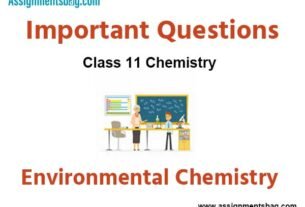Please refer to Assignments Class 11 Biology Anatomy of Flowering Plants Chapter 6 with solved questions and answers. We have provided Class 11 Biology Assignments for all chapters on our website. These problems and solutions for Chapter 6 Anatomy of Flowering Plants Class 11 Biology have been prepared as per the latest syllabus and books issued for the current academic year. Learn these solved important questions to get more marks in your class tests and examinations.
Anatomy of Flowering Plants Assignments Class 11 Biology
Question. Parenchymatous cells with large intercellular spaces which occupy the central portion of the stem constitute
(a) Cortex
(b) Pith
(c) Hypodermis
(d) Epidermis
Answer
B
Question. The outside of the epidermis is often covered with a waxy thick layer, called
(a) Hypodermis
(b) Cuticle
(c) Root hair
(d) Stem hair
Answer
B
Question. After secondary growth what is the actual future of primary xylem ?
(a) Converts into secondary xylem
(b) Remains more or less intact in or around the centre
(c) Converts into secondary phloem
(d) Gets crushed
Answer
B
Question. In grasses, certain adaxial epidermal cells along the veins modify themselves into large, empty, colourless cells. These cells are called :-
(a) Bulliform cells
(b) Starch sheath cells
(c) Companion cells
(d) Complimentary cells
Answer
A
Question. Regarding to stele which of the following statement is correct ?
(a) All the tissues lies inner to pericycle
(b) All the tissues lies inner to endodermis
(c) All the tissues lies inner to hypodermis
(d) All the tissues lies inner to epidermis
Answer
D
Question. During secondary growth in dicot stem, At some places, the cambium forms a narrow band of parenchyma , which passes through the secondary xylem and secondary phloem in radial directions. These are called :-
(a) Sap wood
(b) Heart wood
(c) Secondary medullary rays
(d) Primary medullary rays
Answer
C
Question. Which of the following is primary meristem ?
(a) Apical meristem
(b) Intercalary meristem
(c) Lateral meristem
(d) Both a and b
Answer
D
Question. Regarding to collenchyma find out the incorrect statement
(a) It’s cell walls show pecto-cellulosic unlignified thickenings
(b) Intercellular spaces are generally absent
(c) Provide mechanical support to petiole of a leaf
(d) Found in the form of a layer below epidermis in monocots
Answer
D
Question. Sclereids are present in
(A) Fruit wall of nuts
(B) Pulp of guava, pear and sapota
(C) Seed coat of legume
(a) Only A
(b) Only B
(c) Only C
(d) All A, B and C
Answer
D
Question. Cuticle is absent in
(a) Roots
(b) Dicot Stem
(c) Leaves
(d) Monocot stem
Answer
A
Question. Match the following :-
| (a) Parenchyma | (i) Pericycle of root |
| (b) Collenchyma | (ii) Hypodermis of dicot stem |
| (c) Sclerenchymatous | (iii) Pericycle of stem fibres of Linum |
| (d) Sclerenchymatous | (iv) Pulp of pear sclereids |
(a) i ii iii iv
(b) iv iii ii i
(c) i ii iv iii
(d) i iii ii iv
Answer
A
Question. The parenchymatous cells lies between xylem & phloem of root is known as
(a) Cambium
(b) Conjunctive tissue
(c) Pith
(d) Pericycle
Answer
B
Question. Consider the following statements.
(a) Phloem fibres are made up of sclerenchy-matous cells
(b) Phloem parenchyma are generally present in monocots
(c) The first formed primary phloem consists of narrow sieve tube and is referred to as protophloem and the later formed phloem has bigger sieve tubes and is referred to as metaphloem Which statement(s) is/are false ?
(a) Only a
(b) Only b
(c) Only c
(d) a, b, and c
Answer
B

